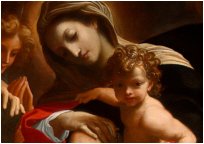St. Colman finds Society in Solitude in the deep Burren Forest
595 A.D. (  ) )
 n 595 A.D. (
n 595 A.D. ( ) St. Colman set out to be a hermit within the solitudes of the Burren forest. The Burren "ranges" form the mountain barriers which divide Aidhne on the southwest from the rugged defiles of Corcomroe. The Burren forest at that time was very dense, with pines, oaks and ash trees without number. St. Colman sought in the depths of the Burren, for perfect solitude and seclusion to commune alone with his Creator, like another St. Anthony of the Desert. ) St. Colman set out to be a hermit within the solitudes of the Burren forest. The Burren "ranges" form the mountain barriers which divide Aidhne on the southwest from the rugged defiles of Corcomroe. The Burren forest at that time was very dense, with pines, oaks and ash trees without number. St. Colman sought in the depths of the Burren, for perfect solitude and seclusion to commune alone with his Creator, like another St. Anthony of the Desert.
He had resolved to give himself to the practices of penance and contemplation with all the strength of his soul in complete solitude and retirement. Providentially, the Burren Forest was well fitted to be a hermit's chosen home.
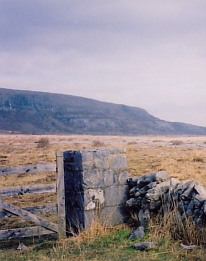
End of public road: Burren Forest from afar |
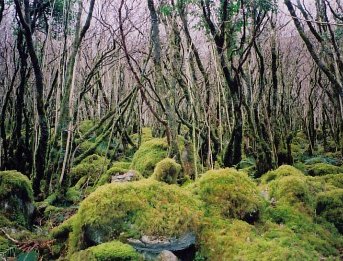
Within the Burren Forest in route to St. Colmans's Holy Cave |
St. Colman's Cell (Cave) in the Burren
St. Colman's Grotto or "Leaba Mhic Duagh," (His Cave) has remained perfectly preserved for more than fourteen hundred years and is situated on a steep elevation about 30 ft. above the oratory. It is about 15 ft. long, by 4 or 5 at its greatest width. A tall man with ease can stand erect within it.
One of the famous and miraculous stories which has been told for centuries throughout Ireland in connection with St. Colman Mac Duagh's stay in his Burren hermitage is as follows:
"St. Colman was retired into the wilderness for the benefit of his devotion. He had no living creature about him except a rooster, a mouse, and a fly. The use of the rooster was to give him notice of the time of night by his crowing, that he might know when to apply himself to his prayers. The mouse had a proper office, which was to prevent the Saint from sleeping above five hours within the space of twenty-four; for, when the business of his devotion, which he exercised with great reverence and regularity upon his knees, had so fatigued his spirits that they required a longer refreshment, the mouse would come to his ears and scratch him with his feet till he was perfectly awake. The fly always attended on him when he was reading. It had the sense to walk along the lines of the book; and when the Saint had tired his eyes, and was willing to desist, the fly would stay upon the first letter of the next sentence, and by that means direct him where he was to begin."
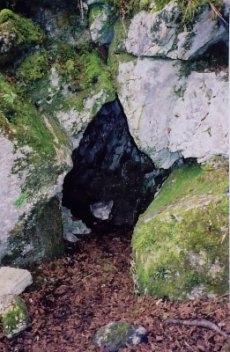
Outside of St. Colman's Cave
in the Burren Forest |
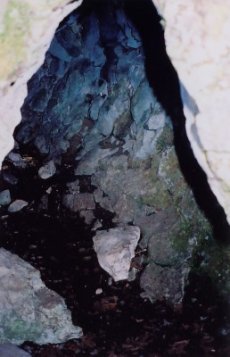
Entrance to St. Colman's Cave |
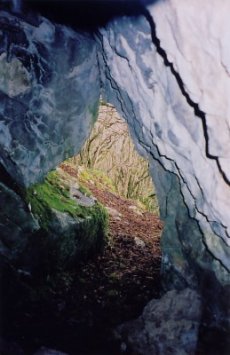
Looking out from within of
St. Colman's Cave |
Regarding St. Colman's stay in the Burren, Father J. Fahey, DD., VG an Irish priest and chronicler of the life of St. Colman and great admirer wrote:
"For seven long years [St. Colman] lived in his Burren hermitage, completely hidden and unknown. Yet how quickly the years had sped! The songs of the forest birds, and the music of the mountain streams, and the whisperings of the breezes as they stirred the rustling leaves, had grown familiar and dear to him during those seven summers past, and the remembrance of them seemed like the recollection of some happy and tranquillizing dream. How could he forget the long prayers, happily uninterrupted by the turmoil of the world, offered there beneath the vault of heaven."
St. Colman's Oratory
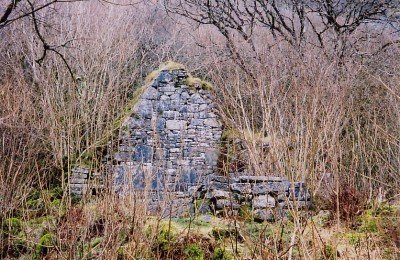
Structural remains of St. Colman's Oratory where he offered Holy Mass |
St. Colman constructed a small oratory at the base of the tall cliff of "Ceanaille." In fact to this day there still are the remains of this oratory and the cave close to his oratory in which he sought shelter and rest. A crystal fountain supplied him with drink. The wild herbs of the forest were his only food, and the skins of the wild deer formed his coarse clothing. Here shut out from all human converse, and dead to all earthly things, St. Colman led a life of the highest spirituality. Through his seemingly continual fasts, prayers and vigils he became so imbued with a sense of the Divine love that he was frequently wrapped in ecstasy, and enjoyed the most abundant spiritual consolations.
As Fr. Fahey wrote regarding the Burren Oratory,
"...the Burren Mountains...encloses within its sheltering embrace the ruins of the unpretending oratory in which the Saint so often prayed and offered the Holy Mass ...The very spirit of solitude seems to pervade the place, and to assert its sovereignty. On the crest of the cliff the Burren eagles have their eyrie. Save the mountain goat, which safely leaps from crag to crag along the ivy-covered ledges of the rock, few other living things are seen ...it is rarely that one sees a more striking view than that which is commanded by the plateau in which St. Colman's oratory is situated."
It is widely speculated that many years later the heretic Oliver Cromwell and his followers were guilty of the sacrilegious plunder of this holy oratory. Fr. Fahey justly states:
"...though ruined for centuries, the memory of [the great St. Colman] has invested this oratory with an interest in the minds of the people and the district, which time cannot destroy. Though wrecked and ruined, it remains a sacred shrine. Within the solitudes of those eternal hills it has preserved imperishably for over [fourteen] centuries the fame of St. Colman's sanctity. It is a monument more imperishable than sculptured marble."
Holy Well in Burren
There is a beautiful natural fountain close to the oratory which is dedicated to St. Colman with the purest of water flowing from it. This Holy Well is enclosed by a circular structure and its water is said to posses healing properties for the faithful who drink or apply it to themselves.
| 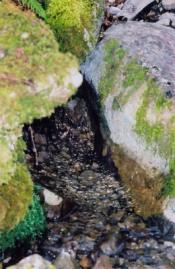
Beautiful Holy Well fountain at St. Colman's Oratory |
Hospitable King Guaire Aidhne & The Road of the Dishes
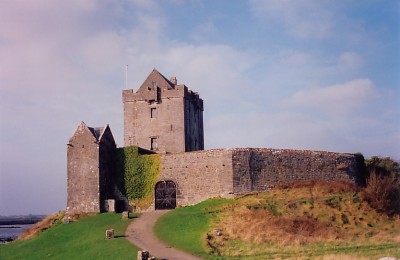
Dungugaire, former site of King Guaire's Palace (Kinvara, Ireland) |
Divine Providence made itself clear in a miraculous way that St. Colman was to leave his beloved retreat and stand before all of Ireland and the world, as a burning light and testament to the truths of the Holy Catholic Faith. This was shown clearly to St. Colman in the following supernatural way:
There was a Hospitable King named Guaire Aidhne who lived in Kinvara (which is close to the Burren) who had no knowledge of the presence of his holy kinsmen (St. Colman) who resided hidden fairly close by. On Easter morning in the last decade of the 6th Century, St. Colman recited the divine office and offered the sacred mysteries (said Mass). He had performed his usual exercises of austerity which included a rigorous Lenten fast and found himself without suitable food for the Easter meal. At that exact same time King Guaire was having his royal banquet, which had been procured specially for the occasion by the king's huntsmen, set before him on the royal tables for him and his court to partake of. Before sitting down to the sumptuous feast, King Guaire exclaimed,
"Oh, would it pleased Heaven that this banquet were set before some true servants of God who require it; as for us, we might easily be provided with another."
He had no sooner spoken than the dishes were removed by invisible hands. All were struck with awe. The king, amazed at the marvel, summoned his mounted guard to follow and discover if possible, the destination of the dishes. His whole court, and the people from the district which they passed through, followed the dishes in hot pursuit. The dishes, which were being carried by angels, sped on through the air and finally were deposited with all their fine fares in an open space in front of St. Colman at his Burren hermitage. St. Colman was then informed by an angel that the feast was sent by Divine Favor and through the benevolence of the Catholic Magistrate (King Guaire). The King and his retinue soon arrived and were astonished at discovering the oratory and cell and seeing the banquet spread out before the holy hermit St. Colman.
It had pleased God to manifest in a most striking manner the singular sanctity of His Servant to the king and the assembled multitude. The favor which St. Colman Mac Duagh had found with God was thus manifested to the world, despite his humble efforts to hide himself. To this day the route that King Guaire took through the mountain gorge is called "Bohir na Maes," i.e., The Road of the Dishes.
Next: Monastery at Kilmacduagh >>
|
